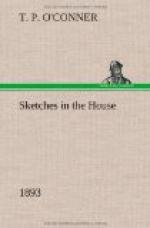Devotional, almost pietistic, introspective, accustomed, I have no doubt, from that early training of domestic piety and sacerdotal surroundings, to see all this gay, vast phantasmagoria of life the antechamber to a greater, more enduring, and better world beyond those voices, Mr. Gladstone—at least that is my reading of his character—looks at everything in human existence with the power of self-detachment from its garish moments and its transient interests. Behind this constant warfare, underneath all this public passion and sweeping resolves, there is a nether and unseen world of thought, emotion, hope, and in that world there is ever calm. It is a tabernacle in his soul where only holy thoughts may enter. Outside its impenetrable and echoless walls are left behind the shouts of faction, the noise of battle, the rise and fall of the good and ever-enduring fight between wrong and right. Within that tabernacle Mr. Gladstone has the power of withdrawing himself at will, just as in the Agora of Athens, and on the last great day when he discoursed on immortality, and drank the mortal hemlock, Socrates could withdraw himself, and listen to the inner whisper of his daemon. All this, I say, you could see in the abstracted, resigned and composed look of Mr. Gladstone at the moment when his triumphant enemies, in their summer garb, with their smiling faces, and strutting walk, entered the House of Commons. If you wanted to see at once the contrast, not only of the temper of the hour, but the still greater and more momentous contrast of temperaments, you had only to look from the face of Mr. Gladstone to that of Mr. Chamberlain. The contrast of their years—the deeper contrast of their natures—above all, the profounder contrast of their worlds of thought, training and environment—all were brought out. In that perky, retrousse-nosed, self-complacent, confidently smiling man you saw all the flippancy—so-called realism—the petty commercialism of the end of the middle of the nineteenth century. The mysticism, the poetry, the rich devotion, the lofty and large ideals of the beginning of the century—of the time that remembered Byron and produced Newman—all these things were to be seen in the rapt look of that noble, beautiful and refined face on the Treasury Bench. And yet there was something more. The brilliant light of the early days of our century has become dim and cold in those hearts and minds which have not had the power to grow and expand with their ages. But with that splendid sanity of body as well as mind which belongs to him, Mr. Gladstone is the creature of the ending of the nineteenth as of the beginning of the twentieth century. Like the man of Arctic climes, he stands almost at the same moment in the sunset of one great century and the heralding light of the sunrise of another.
CHAPTER XIV.
THE BURSTING OF THE STORM.
[Sidenote: An Indian summer.]




